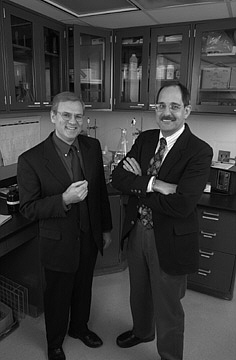|
|
Center to Study Urban Toxic WasteBy Phil SneidermanHomewood |

Abandoned factories and contaminated soil can stall efforts to revive blighted urban neighborhoods. That's because city officials, developers and nearby residents often share common concerns: Is it safe to rebuild here? Will workers and residents become ill from toxic materials that escape into the air and water supplies?
A new research center, led by engineers and scientists at Johns Hopkins, plans to address these fears by creating tools to gauge risks associated with hazardous waste sites and by developing ways to clean up harmful pollutants. The U.S. Environmental Protection Agency recently approved a five-year $5.2 million grant to launch this Center for Hazardous Substances in Urban Environments, based at Hopkins.

|
| Ed Bouwer, right, and Hedy Alavi are serving as director and associate director, respectively, of the new Center for Hazardous Substances in Urban Environments. |
The funds will support research and allow center participants to provide technical help to community groups; state, municipal and local environmental regulators; and industry representatives in the Northeast. Researchers from four other institutions--the University of Maryland, Morgan State University, the University of Connecticut and the New Jersey Institute of Technology--will participate in the new center and share in the EPA grant.
The Hopkins-based center is one of five new Hazardous Substance Research Centers, affiliated with 22 universities, recently funded by the EPA with more than $22 million in research grants.
"Before we applied for this grant, we asked regional EPA officials about the most serious challenges they faced," said Ed Bouwer, a professor of geography and environmental engineering in the Whiting School of Engineering who serves as the center's director. "One of the top issues they mentioned was urban livability--making sure that people in cities have air, water and soil that will not expose them to toxic substances. The other big issue was brownfields--abandoned lots and buildings that may contain hazardous materials. If you can redevelop these properties, you can create jobs and improve the tax base. So the cities and states have an economic incentive to promote new construction on the brownfields if the environmental concerns can be addressed."
That's where the new center comes in. Bouwer and his colleagues are developing new tests and computer models to identify chemicals that are present on blighted sites and determine whether they are spreading away from the sites through rainfall runoff or aboard windswept dust particles. These new tracking methods should help local officials, developers and community leaders decide on the best way to remove or neutralize the hazardous wastes. In some cases, the researchers may conclude that the Earth's natural self-cleansing process will eliminate the hazard if the property is merely left alone for a specified period of time.
"We're creating tools to help assess these waste sites, so that we can determine how much of a problem really exists at each one," Bouwer said. "Determining the relative risks will help us decide the best way to manage that site."
Under the auspices of the center, Johns Hopkins faculty members are pursuing four new research projects:
 Marc Parlange,
professor of geography and environmental engineering, and
Charles Meneveau, professor of
mechanical engineering,
are leading a team that will use LIDAR, a variation of radar
that uses light instead of radio waves, to identify airborne
pollutants and track their movement through an urban
atmosphere.
Marc Parlange,
professor of geography and environmental engineering, and
Charles Meneveau, professor of
mechanical engineering,
are leading a team that will use LIDAR, a variation of radar
that uses light instead of radio waves, to identify airborne
pollutants and track their movement through an urban
atmosphere.
 Bouwer and Bill
Ball, professor of geography and environmental engineering,
are developing a method to determine how quickly buried
pollutants move through the soil as a result of rainfall
infiltration and groundwater flow.
Bouwer and Bill
Ball, professor of geography and environmental engineering,
are developing a method to determine how quickly buried
pollutants move through the soil as a result of rainfall
infiltration and groundwater flow.
 Alan Stone and
Charles O'Melia, professors of geography and environmental
engineering, are developing a new test to measure the
toxicity and mobility of chromium at a waste site.
Alan Stone and
Charles O'Melia, professors of geography and environmental
engineering, are developing a new test to measure the
toxicity and mobility of chromium at a waste site.
 Lynn Roberts,
associate professor of geography and environmental
engineering, and Howard Fairbrother, assistant professor of
chemistry, are devising a new filter
that can turn toxic vapors vacuumed out of a waste site into
a harmless mixture of salt, water and carbon dioxide.
Lynn Roberts,
associate professor of geography and environmental
engineering, and Howard Fairbrother, assistant professor of
chemistry, are devising a new filter
that can turn toxic vapors vacuumed out of a waste site into
a harmless mixture of salt, water and carbon dioxide.
The center will devote 30 percent of its budget to outreach activities, providing information to the regulators, consultants and citizens who will help decide the future of urban hazardous waste sites. In his role as associate director of the new center, Hedy Alavi, a geography and environmental engineering lecturer, will supervise the outreach program.
Related Web Sites
Center for Hazardous Substances in Urban
Environments
Johns Hopkins Department of Geography and Environmental
Engineering
EPA Grant Announcement
| GO TO JANUARY 7, 2002 TABLE OF CONTENTS. |
| GO TO THE GAZETTE HOME PAGE. |